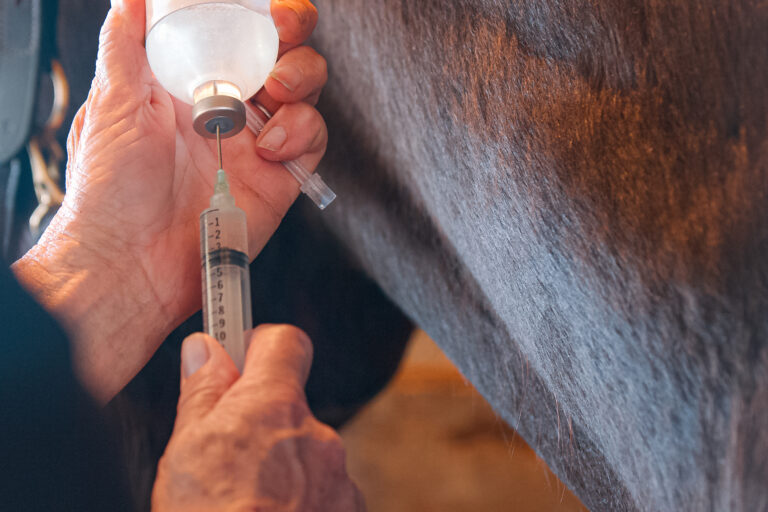
An animal’s veterinary medical record, as the name implies, is a complete history of the patient’s clinic visits or field calls, examinations, diagnoses and treatments. The record is an archive of the animal’s veterinary care in the past, a road map for care in the future, a guide for accurate client billing and an important communication tool to prevent misunderstandings between veterinarians and their clients.
Less obvious, but equally important, a medical record can be the first, and best, line of defense for a veterinarian facing a malpractice claim—but only if the record is complete and accurate.
Steven Sedrish, DVM, from Upstate Equine Medical Center in Schuylerville, New York, discussed the importance of a legally defensible medical record, and how to create one, at the American Association of Equine Practitioners 59th Annual Convention on Dec. 7-11, 2013.
“Any medical record can wind up in court,” Sedrish said, “and a single mistake can put the entire file in question.” Some of his recommendations may sound like nit picking, but they all will help veterinarians avoid the uncomfortable task of trying to defend a malpractice lawsuit with a questionable medical record.
- Report potential malpractice claims. The first step for a veterinarian practicing what Sedrish called “defensive medicine” is to notify the malpractice carrier at the first suspicion of a claim. Failure to notify the carrier in a timely manner may void the coverage. In addition, the carrier and the company’s attorneys have the expertise to advise the veterinarian about how to proceed and what records to retain.
- Write all entries in blue or black ink. He said that veterinarians should avoid making entries in pencil (to avoid subsequent claims that records were erased or altered after entry) or in red ink (to avoid the stigma associated with red marks indicating a mistake that we all inherited from grade school). All entries should include the date, time and the signature or initials of the veterinarian making the notation. Handwriting should be legible and the use of uncommon abbreviations should be avoided for clarity.
- Leave no blank lines. Gaps in the record might suggest that the veterinarian intentionally left a portion of the document blank to be filled in later if problems, or litigation, arose. For the same reason, Sedrish recommended that notations outside the margins or outside the lines might create the impression that they were added later, and not made contemporaneously. If additions must be made to the record, he added, they should be included in a signed and dated addendum.
- Indicate incorrect information with a single line. An incorrect entry, or any information that must be changed, should be indicated with a single line drawn through it, along with the date, time, signature and explanation of why the entry was crossed out. It is important, Sedrish explained, for someone to be able to read what was crossed out.
- Include everything. The record should include all treatments, physical examinations, procedures and observations (even the mundane ones like stall cleaning or water consumption). It is important to include normal findings as well as those that indicate a problem, Sedrish added, because they can provide a baseline as well as establishing that the horse was being monitored on a regular basis. On field calls, he added, the physical examination should be recorded in detail, including the treatment administered and the reasons for the treatment. Horses are weighed when admitted and when discharged from Sedrish’s clinic, both to establish the horse’s condition and to provide information for more accurate medication dosages. He also photographs horses before and after treatment, and he includes photographs of lesions in an animal’s medical record to help assess the progress of treatment.
- In addition to medical information, a complete medical record should include summaries of every conversation the veterinarian has with the horse’s owner and trainer, with the insurance agent, with referring or consulting professionals, and with anyone else involved in the care of the patient. Equine veterinarians have unique problems that make communications especially important, Sedrish said. Their practices are ambulatory; they often rely on a horse’s owner or trainer for restraint of the animal; there may be multiple relationships with owners, trainers, grooms, farm owners and managers, and other individuals; there may be multiple owners or interests; and many of their patients have a high value. A contemporaneous record of all communications, whether in person, or by telephone, email, or text message, is one way to demonstrate a mutual understanding between the veterinarian and the client or other interested party.
- Include consent forms. Client consent for treatment should be documented in the medical record with a form signed by the horse’s owner or by the owner’s agent. This is not always possible, Sedrish said, and when consent is given by telephone he suggested having two individuals acknowledge the verbal consent. Both individuals should document the consent in the medical record, which should be supplemented by a signed consent form as soon as practical.
- Discuss and document all treatment options. Several speakers at AAEP stressed the importance of offering a client all available treatment choices, and Sedrish agreed that explaining the various options is important. He recommended that veterinarians record the projected cost and prognosis for each option discussed with a client, the option selected by the client, and, if possible, the reasons why a particular choice was made. The medical record should include any recommended referrals or consultations, and whether the client accepted or refused the recommendations. Not all cases require referral to a specialist or to another veterinarian, Sedrish added, but owners should be given the option.
- Include invoices in the medical record. Sedrish recommended that veterinarians have clients sign invoices after farm calls as an acknowledgment that the described treatments actually were administered. Signed invoices also may serve as evidence of client consent to a procedure in some situations, but the consent requirements vary widely from state to state. It is incumbent upon veterinarians to familiarize themselves with the laws in their own states and to obtain the required documentation.
- Print everything. Although it goes against the recommendations for a “green” practice endorsed by another AAEP speaker, Sedrish recommended that veterinarians make hard copies of “everything,” including emails and text messages (both sent and received). All telephone conversations should be summarized in writing, and Sedrish recommended follow-up emails or text messages to confirm that the client understood what the veterinarian said. It also is important to have evidence that letters and facsimiles were sent as claimed. The United States Post Office offers a certificate of first-class mailing to establish that a letter was mailed, and reports of successfully transmitted facsimiles should be retained as evidence that the document was sent.
Finally, Sedrish stressed the importance of maintaining the confidentiality of client/patient medical records and the potential dangers imposed by the growing use of social media.
“Always remember that anything you post on the Internet stays on the Internet, and it can come back to haunt you,” he said. “Don’t post anything on the Internet that you don’t want to defend in court.”

![[Aggregator] Downloaded image for imported item #18385](https://s3.amazonaws.com/wp-s3-equimanagement.com/wp-content/uploads/2025/09/30141329/EDCC-Unbranded-11-scaled-1-768x512.jpeg)
![[Aggregator] Downloaded image for imported item #19123](https://s3.amazonaws.com/wp-s3-equimanagement.com/wp-content/uploads/2025/12/22164801/GettyImages-825125882-1-scaled-1-768x512.jpg)
![[Aggregator] Downloaded image for imported item #18374](https://s3.amazonaws.com/wp-s3-equimanagement.com/wp-content/uploads/2025/09/30140012/EDCC-Unbranded-28-scaled-1-768x512.jpeg)
